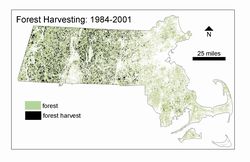You are here
Forest Harvesting in Massachusetts: Influences on Stand Composition and Invasive Plant Species
Harvesting is widespread across the western two-thirds of Massachusetts and is expected to continue into the future.  Comprehensive spatial data on harvesting activities are generally lacking, particularly for the non-industrial private forest (NIPF) lands that comprise ~80% of forests in the state. Massachusetts Executive Office of Environmental Affairs (EOEA) has a unique, spatially-explicit data set developed for regulatory purposes that can be analyzed to provide important information for management and conservation planning. We have initiated a study to document forest harvesting patterns across Massachusetts from 1984-2003 and to evaluate the influence of harvesting on residual forest composition, tree regeneration, and invasive species distribution.
Comprehensive spatial data on harvesting activities are generally lacking, particularly for the non-industrial private forest (NIPF) lands that comprise ~80% of forests in the state. Massachusetts Executive Office of Environmental Affairs (EOEA) has a unique, spatially-explicit data set developed for regulatory purposes that can be analyzed to provide important information for management and conservation planning. We have initiated a study to document forest harvesting patterns across Massachusetts from 1984-2003 and to evaluate the influence of harvesting on residual forest composition, tree regeneration, and invasive species distribution.
This summer we will begin field work across central and western Massachusetts to
- document forest cutting patterns,
- describe their spatial and quantitative characteristics with regards to important forest resource values and physical, cultural, and environmental factors and
- evaluate the influence of harvesting activity on residual stand composition, forest regeneration, invasive species distribution, and vegetation structure and composition.
We have received funding for this project from Sweetwater Trust, The Nature Conservancy, and USDA.
This study is a collaborative effort with The Nature Conservancy and results from this study will help inform regional conservation efforts. In addition, information that we gather will allow MA Department of Conservation and Recreation (DCR) staff to assess regional forest management concerns (i.e., high grading and invasive species).
Two new post-docs have been hired to collaborate on this project:
- Mike Bank is currently finishing his Ph.D. at the University of Maine and will arrive in early May
- Rob McDonald recently finished his Ph.D. at Duke University and will arrive in mid-June.

